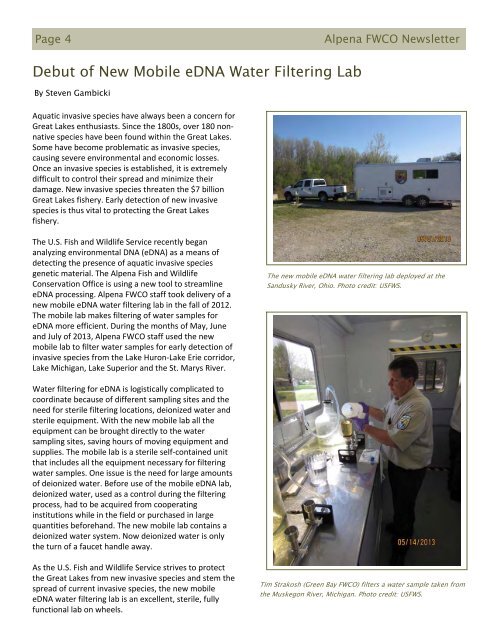July - U.S. Fish and Wildlife Service
July - U.S. Fish and Wildlife Service
July - U.S. Fish and Wildlife Service
You also want an ePaper? Increase the reach of your titles
YUMPU automatically turns print PDFs into web optimized ePapers that Google loves.
Page 4<br />
Alpena FWCO Newsletter<br />
Debut of New Mobile eDNA Water Filtering Lab<br />
By Steven Gambicki<br />
Aquatic invasive species have always been a concern for<br />
Great Lakes enthusiasts. Since the 1800s, over 180 nonnative<br />
species have been found within the Great Lakes.<br />
Some have become problematic as invasive species,<br />
causing severe environmental <strong>and</strong> economic losses.<br />
Once an invasive species is established, it is extremely<br />
difficult to control their spread <strong>and</strong> minimize their<br />
damage. New invasive species threaten the $7 billion<br />
Great Lakes fishery. Early detection of new invasive<br />
species is thus vital to protecting the Great Lakes<br />
fishery.<br />
The U.S. <strong>Fish</strong> <strong>and</strong> <strong>Wildlife</strong> <strong>Service</strong> recently began<br />
analyzing environmental DNA (eDNA) as a means of<br />
detecting the presence of aquatic invasive species<br />
genetic material. The Alpena <strong>Fish</strong> <strong>and</strong> <strong>Wildlife</strong><br />
Conservation Office is using a new tool to streamline<br />
eDNA processing. Alpena FWCO staff took delivery of a<br />
new mobile eDNA water filtering lab in the fall of 2012.<br />
The mobile lab makes filtering of water samples for<br />
eDNA more efficient. During the months of May, June<br />
<strong>and</strong> <strong>July</strong> of 2013, Alpena FWCO staff used the new<br />
mobile lab to filter water samples for early detection of<br />
invasive species from the Lake Huron‐Lake Erie corridor,<br />
Lake Michigan, Lake Superior <strong>and</strong> the St. Marys River.<br />
The new mobile eDNA water filtering lab deployed at the<br />
S<strong>and</strong>usky River, Ohio. Photo credit: USFWS.<br />
Water filtering for eDNA is logistically complicated to<br />
coordinate because of different sampling sites <strong>and</strong> the<br />
need for sterile filtering locations, deionized water <strong>and</strong><br />
sterile equipment. With the new mobile lab all the<br />
equipment can be brought directly to the water<br />
sampling sites, saving hours of moving equipment <strong>and</strong><br />
supplies. The mobile lab is a sterile self‐contained unit<br />
that includes all the equipment necessary for filtering<br />
water samples. One issue is the need for large amounts<br />
of deionized water. Before use of the mobile eDNA lab,<br />
deionized water, used as a control during the filtering<br />
process, had to be acquired from cooperating<br />
institutions while in the field or purchased in large<br />
quantities beforeh<strong>and</strong>. The new mobile lab contains a<br />
deionized water system. Now deionized water is only<br />
the turn of a faucet h<strong>and</strong>le away.<br />
As the U.S. <strong>Fish</strong> <strong>and</strong> <strong>Wildlife</strong> <strong>Service</strong> strives to protect<br />
the Great Lakes from new invasive species <strong>and</strong> stem the<br />
spread of current invasive species, the new mobile<br />
eDNA water filtering lab is an excellent, sterile, fully<br />
functional lab on wheels.<br />
Tim Strakosh (Green Bay FWCO) filters a water sample taken from<br />
the Muskegon River, Michigan. Photo credit: USFWS.
















